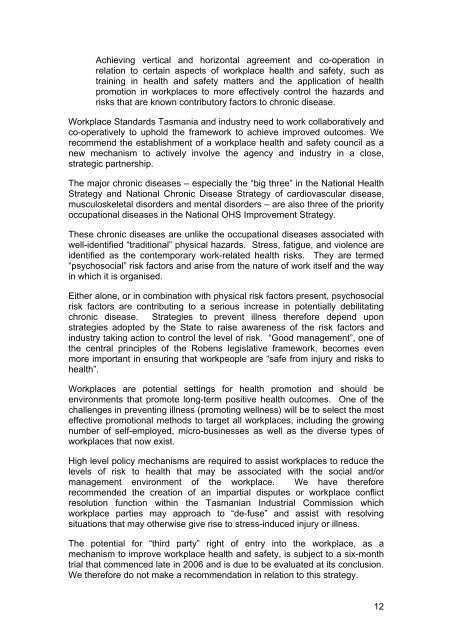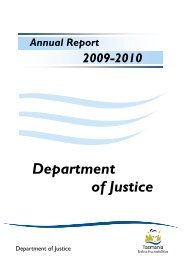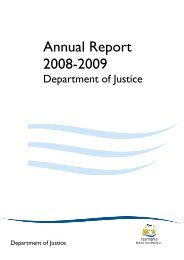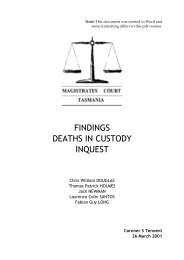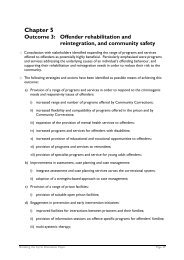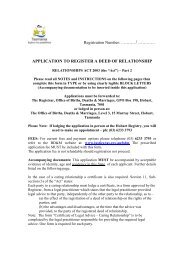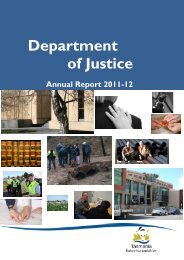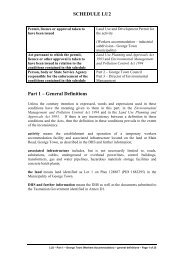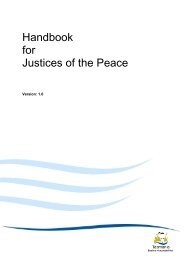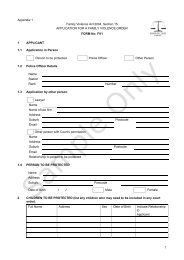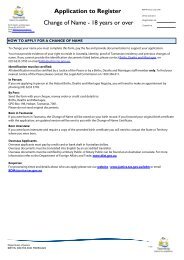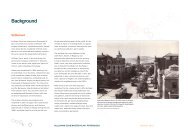View the report - Tasmanian Department of Justice
View the report - Tasmanian Department of Justice
View the report - Tasmanian Department of Justice
You also want an ePaper? Increase the reach of your titles
YUMPU automatically turns print PDFs into web optimized ePapers that Google loves.
Achieving vertical and horizontal agreement and co-operation in<br />
relation to certain aspects <strong>of</strong> workplace health and safety, such as<br />
training in health and safety matters and <strong>the</strong> application <strong>of</strong> health<br />
promotion in workplaces to more effectively control <strong>the</strong> hazards and<br />
risks that are known contributory factors to chronic disease.<br />
Workplace Standards Tasmania and industry need to work collaboratively and<br />
co-operatively to uphold <strong>the</strong> framework to achieve improved outcomes. We<br />
recommend <strong>the</strong> establishment <strong>of</strong> a workplace health and safety council as a<br />
new mechanism to actively involve <strong>the</strong> agency and industry in a close,<br />
strategic partnership.<br />
The major chronic diseases – especially <strong>the</strong> “big three” in <strong>the</strong> National Health<br />
Strategy and National Chronic Disease Strategy <strong>of</strong> cardiovascular disease,<br />
musculoskeletal disorders and mental disorders – are also three <strong>of</strong> <strong>the</strong> priority<br />
occupational diseases in <strong>the</strong> National OHS Improvement Strategy.<br />
These chronic diseases are unlike <strong>the</strong> occupational diseases associated with<br />
well-identified “traditional” physical hazards. Stress, fatigue, and violence are<br />
identified as <strong>the</strong> contemporary work-related health risks. They are termed<br />
“psychosocial” risk factors and arise from <strong>the</strong> nature <strong>of</strong> work itself and <strong>the</strong> way<br />
in which it is organised.<br />
Ei<strong>the</strong>r alone, or in combination with physical risk factors present, psychosocial<br />
risk factors are contributing to a serious increase in potentially debilitating<br />
chronic disease. Strategies to prevent illness <strong>the</strong>refore depend upon<br />
strategies adopted by <strong>the</strong> State to raise awareness <strong>of</strong> <strong>the</strong> risk factors and<br />
industry taking action to control <strong>the</strong> level <strong>of</strong> risk. “Good management”, one <strong>of</strong><br />
<strong>the</strong> central principles <strong>of</strong> <strong>the</strong> Robens legislative framework, becomes even<br />
more important in ensuring that workpeople are “safe from injury and risks to<br />
health”.<br />
Workplaces are potential settings for health promotion and should be<br />
environments that promote long-term positive health outcomes. One <strong>of</strong> <strong>the</strong><br />
challenges in preventing illness (promoting wellness) will be to select <strong>the</strong> most<br />
effective promotional methods to target all workplaces, including <strong>the</strong> growing<br />
number <strong>of</strong> self-employed, micro-businesses as well as <strong>the</strong> diverse types <strong>of</strong><br />
workplaces that now exist.<br />
High level policy mechanisms are required to assist workplaces to reduce <strong>the</strong><br />
levels <strong>of</strong> risk to health that may be associated with <strong>the</strong> social and/or<br />
management environment <strong>of</strong> <strong>the</strong> workplace. We have <strong>the</strong>refore<br />
recommended <strong>the</strong> creation <strong>of</strong> an impartial disputes or workplace conflict<br />
resolution function within <strong>the</strong> <strong>Tasmanian</strong> Industrial Commission which<br />
workplace parties may approach to “de-fuse” and assist with resolving<br />
situations that may o<strong>the</strong>rwise give rise to stress-induced injury or illness.<br />
The potential for “third party” right <strong>of</strong> entry into <strong>the</strong> workplace, as a<br />
mechanism to improve workplace health and safety, is subject to a six-month<br />
trial that commenced late in 2006 and is due to be evaluated at its conclusion.<br />
We <strong>the</strong>refore do not make a recommendation in relation to this strategy.<br />
12


